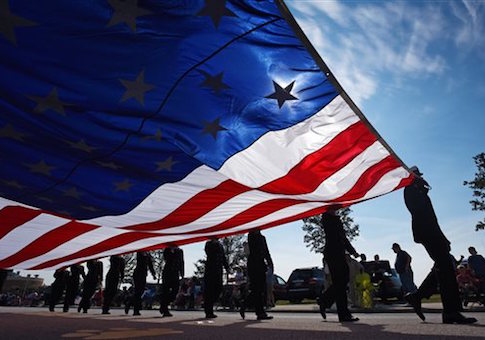Americans with military service backgrounds hold 14 percent of state-level offices, accounting for hundreds of seats in state legislatures.
Veterans from all branches of the U.S. military hold 1,039 of the 7,383 state legislative seats in the United States, according to new research from the American Enterprise Institute. The report shows how former military members have been attracted to civic engagement in their communities even as the number of veterans serving in the U.S. Congress has fallen.
The research offers the first-ever countrywide snapshot of veterans representing their communities in state legislatures, according to Rebecca Burgess, the author of the report. Burgess said the figure has surprised experts and veterans' organizations, who anticipated that the count of veterans holding public office would be much smaller.
The analysis shows that the share of veterans who hold state-level public office (14 percent) is larger than the share of veterans in the adult U.S. population (9 percent).
"That's a much higher number than most people anticipate," Burgess said of the over 1,000 veterans holding state-level political office.
The prevalence of veterans in state legislatures coincides with a high level of public confidence in the military and record-low trust in the federal government.
According to data released last month by the Pew Research Center, 79 percent of American adults trust the military to act in the interests of the public. This stands in contrast to the 27 percent of Americans who trust elected officials to act in the interests of the public, a figure that has plummeted to historic lows in recent years.
Veteran lawmakers such as Sen. John McCain (R., Ariz.) have filled key leadership roles in the U.S. government.
However, the number of veterans in the U.S. Congress has declined considerably since the 1970s, as running for national office has become more expensive and military cuts after the Cold War have reduced the number of veterans in the American population.
"From the high-water mark of the 1970s when veterans made up three-fourths of Congress, with 72 percent in the House of Representatives and 78 percent of the Senate, current levels of veterans in Congress have receded by about 75 percent," states the AEI report released this week. "Only 18 percent of representatives and 20 percent of senators in the 114th Congress include military service on their resumes."
Burgess said the 2016 election will further "undercut" the number of veterans on Capitol Hill. The number of House representatives with military experience will fall from 81 to 73 in the 115th Congress. Two senators in the 2016 freshman class, Tammy Duckworth (D., Ill.) and Todd Young (R., Alaska), have military experience.
Veterans face difficulty fundraising for political office because the jobs they typically accept coming out of the service are not well-suited for establishing contact with wealthy donors. Many veterans find it more financially feasible to run for office at the state level, Burgess said, which could explain why there are veteran legislators in each of the 50 U.S. states but only 33 states have elected national politicians with military experience.
Still, state-level legislative posts provide a springboard for veterans who hope to eventually seek national office, offering political experience and opportunities to build fundraising networks and increase name recognition.
There is a correlation between veteran representation in state districts and congressional districts. Seventy-six districts currently are represented by veterans at the state and national levels.
Veteran state legislators come from all branches of the U.S. armed forces as well as the National Guard and reserves, except for the Coast Guard Reserve. The U.S. Army is best represented in national and state-level offices, followed by the Air Force, Navy, and Marine Corps.
The percentage of veteran legislators varies significantly from one state to the next. Twenty-seven percent of state legislators in Nebraska are veterans while only 5 percent in Utah are veterans.
Veterans in Congress are mostly affiliated with the Republican Party, but states with high levels of veterans in their legislatures are not necessarily red states.
The data provides a snapshot of the current number of veterans in state legislatures, and researchers hope it will serve as a baseline to track "the movement of veterans from state-level public office to national office in Congress."
"Only by filling out that study and tracking future election cycles will we be able to understand the political engagement of veterans, gauge how public-service-minded veterans are in the [all-volunteer force] era, and determine to what extent, as many have speculated, the post-9/11 generation is the new 'greatest generation,' more committed to public service than their parents," the research paper states.
